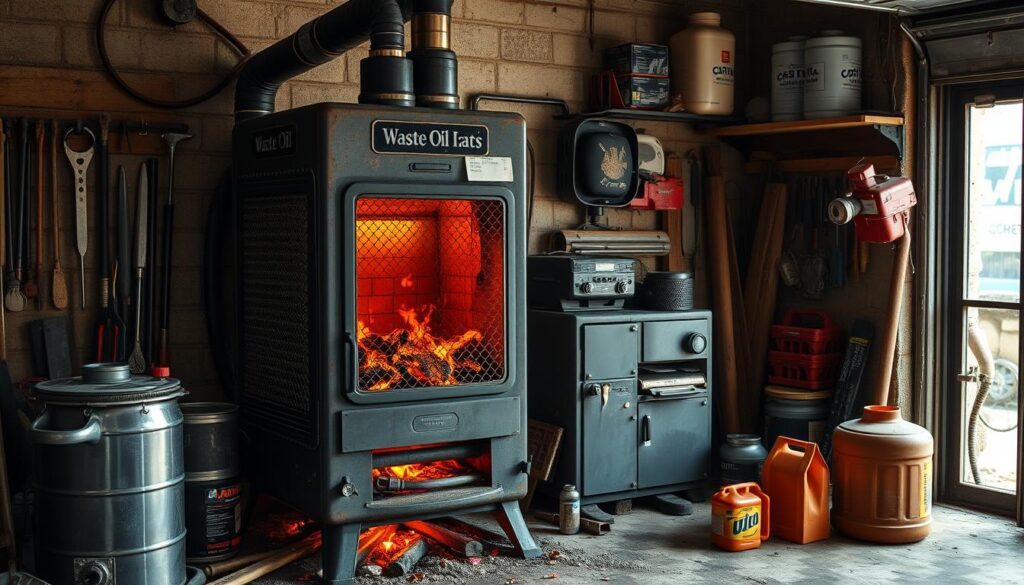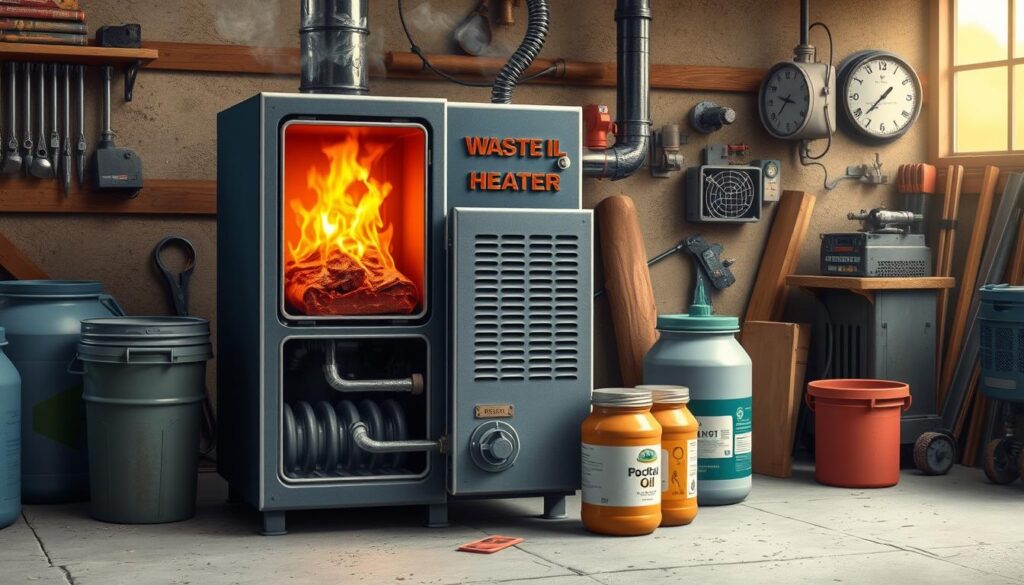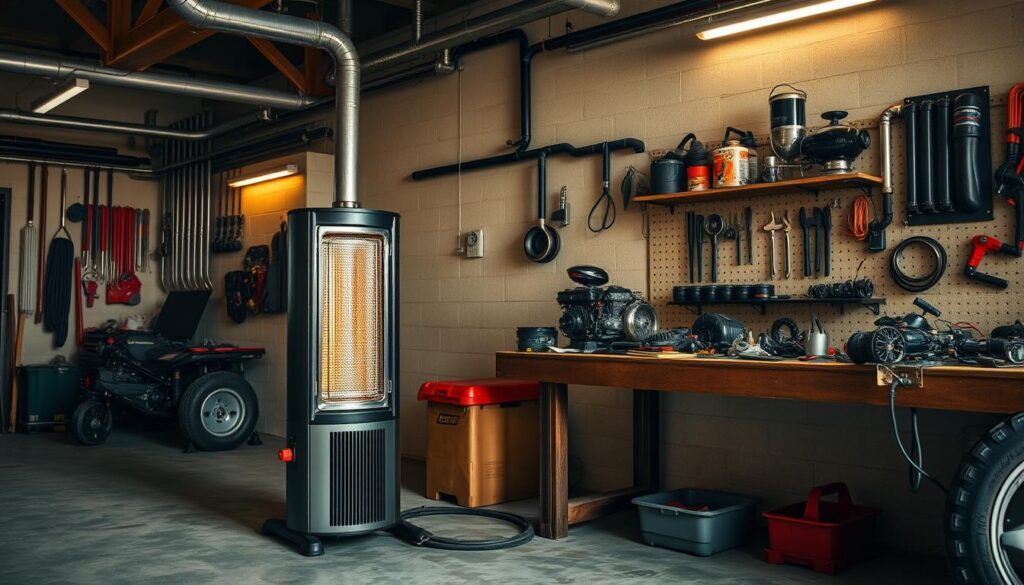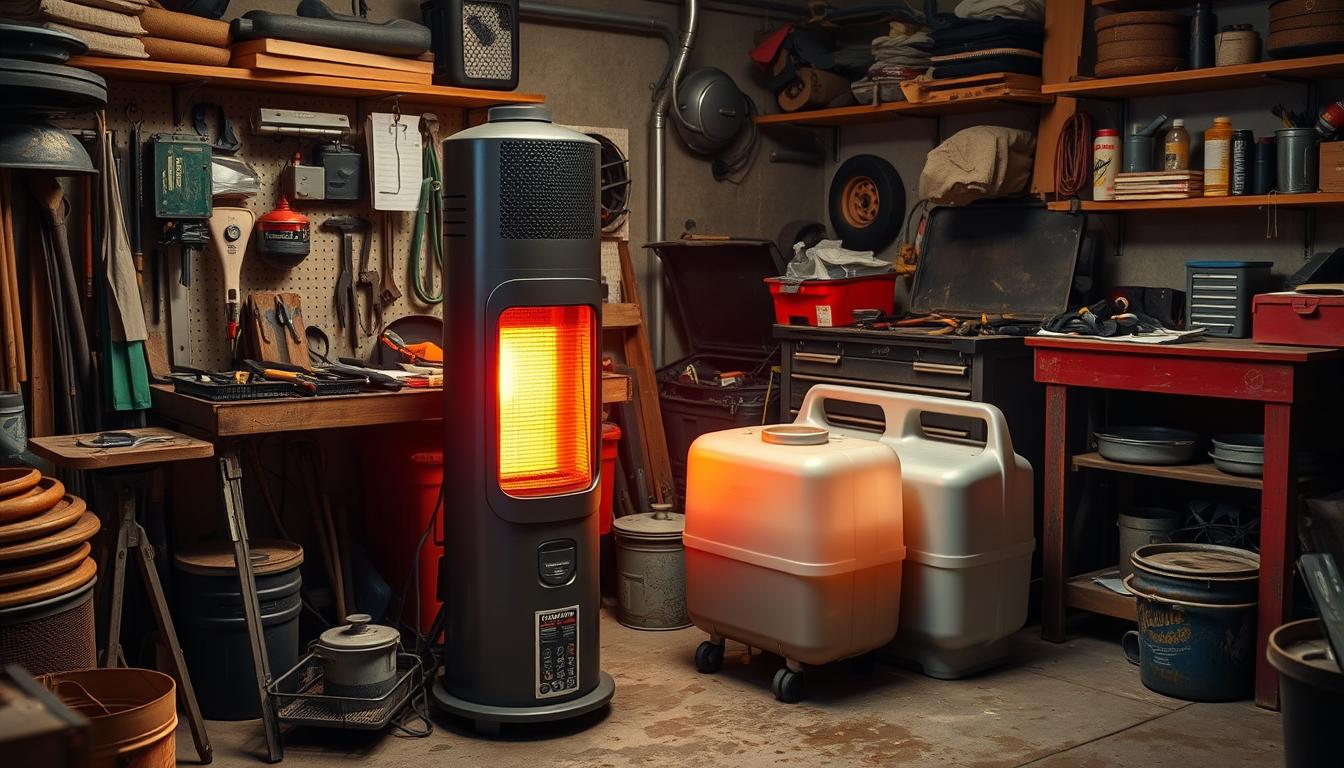Energy costs keep going up, making it key to find good, green heating for garages. The garage heater waste oil system is a smart choice. It turns old oil into heat, saving money and the planet.
These heaters warm up cold spaces and help get rid of waste oil. They’re perfect for car lovers, mechanics, and anyone who works from home. Looking for one? There are many waste oil heaters for sale, so you can pick the right one for you.
Key Takeaways
- The garage heater waste oil system provides eco-friendly heating solutions.
- Used waste oil burning heaters can significantly reduce energy costs.
- This type of heater is ideal for mechanics and car enthusiasts.
- Waste oil burning heaters for garage are available for purchase in various models.
- Recycling waste oil through heating promotes environmental sustainability.
Understanding Waste Oil Heating Systems
Waste oil heating systems are becoming more popular for their energy efficiency. They use leftover oil to heat homes and businesses. This section will explain what waste oil heaters are and their benefits.
What Is a Waste Oil Heater?
A waste oil heater burns used oil to heat spaces. It can use motor or vegetable oils. This makes it a great choice for heating garages.
The heater has a burner that lights the oil. This releases heat that circulates through the area. It’s a green way to heat homes and businesses.
Benefits of Using Waste Oil for Heating
Using waste oil heaters has many benefits:
- Cost Savings: Using waste oil saves a lot of money on fuel.
- Environmental Impact: It reduces the need for traditional fuels, lowering carbon emissions.
- Efficient Heating: These heaters provide a lot of heat, perfect for garages.
- Compatibility: They can easily be added to existing heating systems.
Using waste oil heaters shows a commitment to the environment and efficiency. It’s a smart choice for those who want to save money and keep their garage warm.
Types of Garage Heaters for Waste Oil
Choosing the right garage heater for waste oil is key. There are different types, each with its own strengths. They cater to various needs and preferences. Here are two main types of waste oil heaters often used in garages.
Forced Air Waste Oil Heaters
Forced air waste oil heaters use a fan to spread warm air. They heat up large areas quickly. Their main benefits are:
- Fast Heating: Great for areas that need warmth fast.
- Energy Efficiency: They use waste oil well, saving on costs.
- Portability: Many are easy to move, making them flexible.
Hydronic Waste Oil Heaters
Hydronic waste oil heaters work by circulating heated fluid through pipes. This method keeps the garage warm evenly. Their benefits include:
- Even Heating: Keeps the space warm without cold spots.
- Longer Heat Retention: Warm water holds heat longer, making them efficient.
- Quiet Operation: They’re quiet because they don’t use a fan.

Deciding between forced air and hydronic waste oil heaters depends on your needs. Consider the size of your space, how fast you need heat, and your preference for heating methods. Knowing the differences can improve your garage’s heating experience.
Garage Heater Waste Oil: How Does It Work?
Learning about waste oil heating is key to seeing its benefits. These systems turn used oil into heat for garages and more. They work well when set up right, saving money on heating in winter.
The Mechanics of Waste Oil Heating
It starts with collecting waste oil and cleaning it. This makes sure only pure oil is used. Then, the oil is burned in a special chamber, making heat.
This heat can warm air or a fluid. The fluid then spreads warmth around the space.

Checking efficiency is important for saving money. The Annual Fuel Utilization Efficiency (AFUE) shows how well a heater uses fuel. Higher AFUE means more heat for less fuel, saving money.
Other important numbers are heating output in BTUs. These help pick the right heater for your space.
| Heater Model | AFUE Rating (%) | Heating Output (BTU/hr) |
|---|---|---|
| Model A | 85 | 150,000 |
| Model B | 90 | 175,000 |
| Model C | 80 | 135,000 |
These numbers help choose the best heater. Knowing how waste oil heaters work and these ratings helps heat your space better in cold months.
Choosing the Right Garage Oil Heater for Your Needs
Choosing the right garage oil heater means looking at a few key things. These include size, power, and how easy it is to install. Each of these factors is important for making sure your garage heats up just right.
Factors to Consider: Size, Power, and Installation
When picking a garage oil heater, think about these important points:
- Size: The size of your garage will help decide how big the heater should be. Make sure it’s big enough to warm up the whole area.
- Power: Look at the heater’s BTU rating to see how fast it can heat up. More BTUs mean it can warm up bigger spaces faster.
- Installation: Check if you need a pro to install it or if you can do it yourself. Some heaters need special vents or wiring.
Top Brands in the Market
There are many brands out there for garage oil heaters. Some are known for being the best for waste oil heaters. Here are a few top ones:
| Brand | Features | Warranty | Price Range |
|---|---|---|---|
| Clean Burn | High efficiency, durable construction | 5 years | $3,500 – $5,000 |
| Waste Oil Heater Inc. | Environmentally friendly, reliable performance | 2 years | $2,000 – $4,500 |
| Triad Radiant | Compact design, easy installation | 3 years | $2,500 – $4,000 |

Homemade Waste Oil Heater for Garage: DIY Solutions
Building a homemade waste oil heater for your garage is a great DIY project. It can heat your space well and give you a sense of accomplishment. To build it safely and efficiently, you need to plan carefully. Here are the materials you’ll need and important safety tips for building it.
Materials Needed for Construction
- Waste oil tank (preferably a recycled one for sustainability)
- Burner unit compatible with waste oil
- Pipes for circulation (copper or stainless steel recommended)
- Insulation material to minimize heat loss
- Fan for forced air heating, if desired
- Thermostat for temperature regulation
- Electrical wiring for fan and controls
- Basic hand tools (wrenches, screwdrivers, etc.)
Safety Precautions When Building a Homemade Heater
When making a DIY waste oil heater, safety is key. Here are some important precautions to remember:
- Ensure proper ventilation: Waste oil combustion can produce harmful fumes. Good ventilation is essential.
- Follow local regulations: Check local codes for waste oil heating systems to make sure you comply.
- Use fire-resistant materials: Choosing non-flammable materials can prevent fires.
- Install a fire extinguisher: Having one nearby can give you peace of mind while it’s in use.
- Regularly inspect the heater: Regular checks can help find problems before they get worse.
Best Waste Oil Burning Heaters for Sale
Looking for a waste oil burning heater for your garage? There are many great options out there. This section highlights some top models that people love. They come with different features, so you can find the perfect one for you.
Top Models Reviewed
Some waste oil heaters are known for being reliable and efficient. Here are a few:
- Clean Burn Waste Oil Heater: It’s very efficient and produces a lot of heat while using less energy.
- Schumacher 100,000 BTU Waste Oil Heater: This heater heats up fast, perfect for big garages or workshops.
- HeatStar Waste Oil Heater: It’s small but powerful, great for smaller spaces.
Price Comparisons and Where to Buy
It’s important to find a good deal when buying. Here’s a table comparing prices from different places:
| Model | Retailer | Price |
|---|---|---|
| Clean Burn Waste Oil Heater | Home Depot | $3,200 |
| Schumacher 100,000 BTU Waste Oil Heater | Amazon | $2,500 |
| HeatStar Waste Oil Heater | Walmart | $1,800 |
This table shows the prices, helping you find a heater that fits your budget. Also, reading reviews can help you choose the best waste oil heater for your garage.
Maintenance Tips for Your Waste Oil Heater
Keeping your waste oil heater in good shape is key to its efficiency and longevity. Regular checks and care help avoid common problems. Knowing the basics of maintenance and how to fix issues can save you time and money.
Routine Maintenance Tasks
Regular maintenance boosts your waste oil heater’s performance and safety. Here are some important tasks:
- Change filters often to keep oil flowing smoothly.
- Check the oil’s quality and watch out for water or contamination.
- Clean the combustion area to remove soot and debris.
- Make sure the pump and lines are leak-free and clear.
- Check the flue system for any blockages to ensure good ventilation.
Common Issues and Troubleshooting Steps
Even with regular care, problems can still happen. Knowing how to fix common issues quickly is essential. Here are some common problems and how to solve them:
- Ignition failure: Make sure the spark plug is clean and working. Replace it if it’s not.
- Inconsistent heating: Look for blockages in the oil supply and check the pump’s operation.
- Strange noises: Check for loose parts or blockages inside the heater.
- Excessive smoke: Check the fuel mix and combustion settings for any issues.
- Improper fuel flow: Clear any blockages in the fuel lines and check the pump’s condition.
| Issue | Symptoms | Troubleshooting Steps |
|---|---|---|
| Ignition Failure | Heater does not start | Check spark plug, replace if needed |
| Inconsistent Heating | Heater fluctuates in temperature | Inspect oil supply and pump |
| Strange Noises | Unusual sounds during operation | Tighten loose parts, check for blockages |
| Excessive Smoke | Heavy smoke emission | Adjust fuel mixture and combustion settings |
| Improper Fuel Flow | Poor operation of heater | Clear clogs in fuel lines, check pump functionality |
Environmental Impact of Waste Oil Heating
Waste oil heating systems are good for the planet. They turn waste oil into energy, cutting down on carbon emissions. Many people choose these systems because they’re a green alternative to traditional heating.
How Waste Oil Heaters Reduce Carbon Footprint
Waste oil heaters save money and cut down on greenhouse gases. They use oil that would go to landfills or be harmful. This makes our air cleaner and reduces toxic waste.
Local Regulations and Compliance for Waste Oil Heating
Following waste oil rules is key for users. Local laws guide how to handle and dispose of waste oil. This keeps our environment safe and supports green heating options.
| Aspect | Benefits | Considerations |
|---|---|---|
| Carbon Footprint Reduction | Lower greenhouse gas emissions through recycling oil. | Follows waste oil regulations to prevent illegal disposal. |
| Resource Efficiency | Reduces reliance on fossil fuels, using waste strategically. | Requires knowledge of best practices for waste management. |
| Compliance with Regulations | Training and awareness promote responsible heating practices. | Regular checks to adhere to local laws required. |
Conclusion
Using a garage heater waste oil system has many benefits. It helps save money on energy costs and supports the environment. This method of heating is not just about saving money; it’s also good for the planet.
Waste oil heating systems are not only warm but also green. They are a better choice than old heating methods. Homeowners and businesses can use them to make waste useful again. This reduces our need for traditional energy and helps the planet.
There are many models and brands to choose from. Finding the right one can make your space cozy and cut down on bills. This article has shown many options. It helps you make a smart choice for your heating needs.





